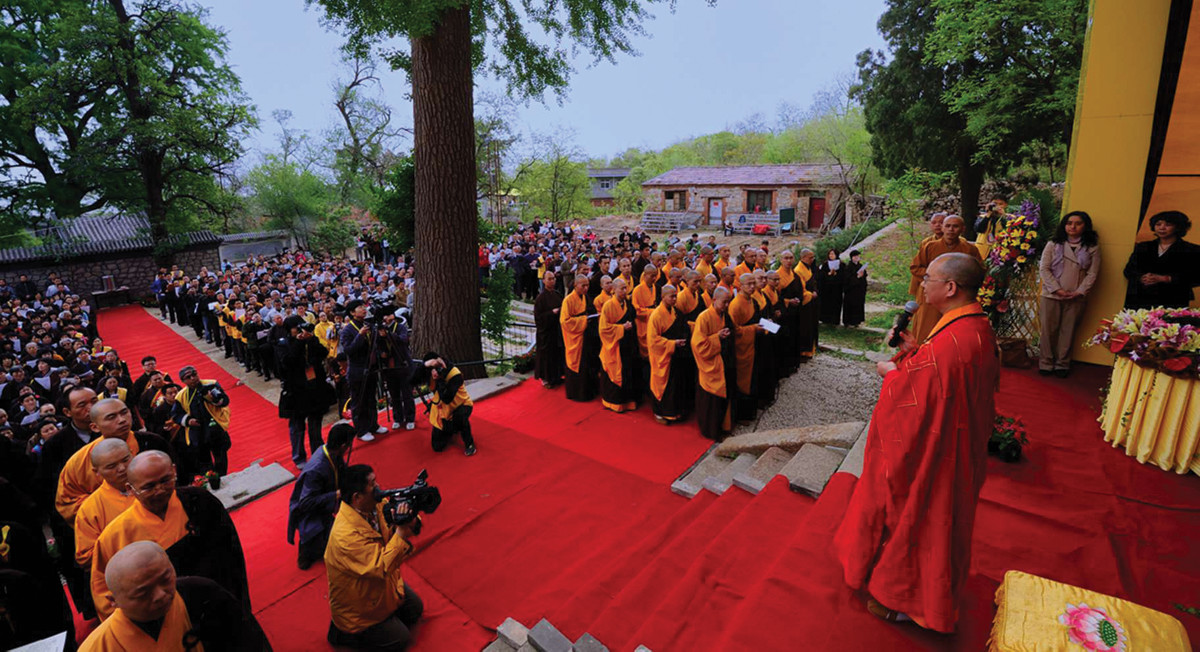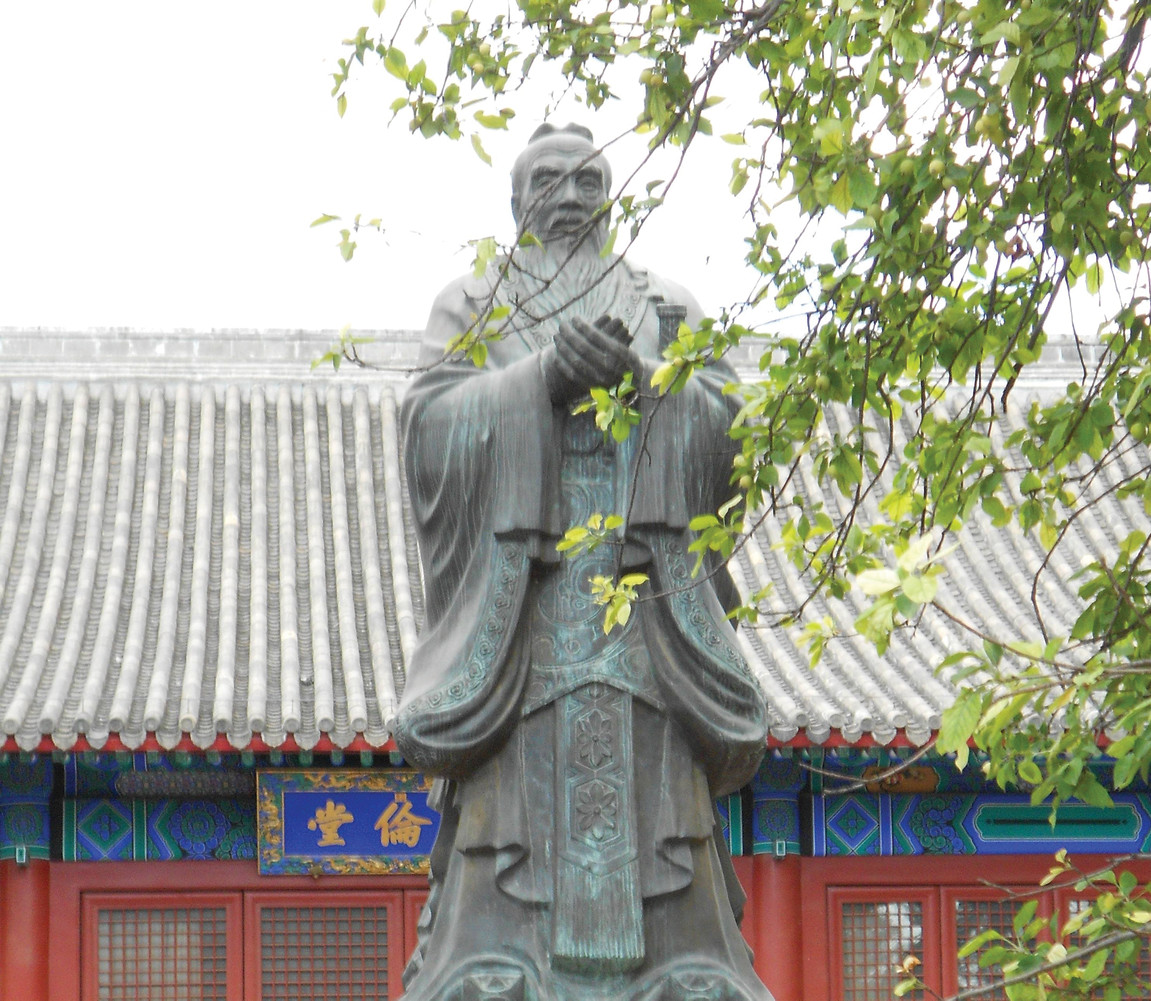Visibility of Religion in Contemporary China
Modernity and new technology permeate China and Chinese culture today, and religion, too, has been transformed and is now manifesting in a way that fits the renewed Chinese reality.
For instance, in late 2007 the city of Nanchang (南昌) in Jiangxi province (江西省) was covered by posters of Confucius (孔子Kǒnɡzǐ) and Laozi (老子Lǎozǐ) wearing western suits with ties. It was the advertising of a local company that wanted to sell western clothing at the same time as conveying spirit and values of Chinese civilisation. In 2010, the movie theatres in China were alternating the screening of Avatar with the local new movie titled Confucius. Directed by Hu Mei (胡玫), it was the famous actor Chow Yun-fat (周润发 Zhōu Rùnfā) who played the role of the Master. Another example of Chinese culture meeting modern technology is the young Buddhist monk Dingkong (定空), who lives in a small village in southern Fujian province (福建省), and has created a blog where he posts photos from liturgies, short comments on Buddhist scriptures, and interacts with believers. Many Buddhist monasteries also run their own websites, updating the community about their activities and also allowing followers to visit ‘online’ Buddha halls and conduct traditional Buddhist rituals. From offering of incense to ancestor worship – all this can be done online nowadays. If you turn on the TV, you can easily find a few channels where Daoist priests or Buddhist monks are preaching scriptures, or TV series that clearly portray Confucian values and virtues. These are just a few examples of how religion manifests itself in modernising China.
Another example of the visibility of religion in China today is the concurrent worship of a plurality of traditions, a revival of public ritual activity, and at the same time the increase of the so-called ‘religious tourism’. In summer 2012, I spent two weeks at Mt. Putuo (普陀山), a mountain island in Zhejiang province (浙江) that is recognised as the sacred site where the Bodhisattva Guanyin (观音菩萨Guānyīn Púsà) resided and practiced. This is one of the four ‘sacred mountains’ of Buddhism in China, the other three being Mt. Wutai (五台山), which is associated with the Bodhisattva Wenshushili (文殊师利菩萨Wénshūshīlì Púsà); Mt. Emei (峨眉山), which is associated with the Bodhisattva Puxian (普贤菩萨Pǔxián Púsà); and Mt. Jiuhua (九华山), which is associated with the Bodhisattva Dizang (地藏菩萨Dìzànɡ Púsà). I was impressed by the number of Chinese visiting the island everyday: some of them were there on vacation and thus merely for touristic purposes, some others wanted to pay homage to Guanyin, but they all burned an impressive amount of incense sticks! I also joined a tour to the nearby Luojia island (珞珈山), and after the pilgrimage to each temple, and the collection of the ‘compassion water’ from a fountain just next to a statue of Guanyin, the visitors were reminded by a Buddhist monk resident on the small island to also worship the local Earth God (土地公Tǔdì Gōnɡ) and burn incense and paper money for him as well. I then visited Beijing (北京), and the Confucius Temple (孔庙Kǒnɡ Miào) was not less crowded. Students who were about to take high school or university exams knotted wish-cards or wish-tablets on the trees surrounding Confucius’s statue.

Copyright: Beijing Longquan Monastery (北京龙泉寺)
When did all these religious traditions appear in China and how did they develop? The great ‘sages’ that form the roots of Chinese civilisation, Kongzi and Laozi, are both thought to have lived in the sixth century. It was around that time that Buddha is said to have lived and preached in India. Buddhist practitioners and material objects (such as books and statues) reached China around the first century B.C., and within a few centuries cross-tradition dialogue and borrowing became key features of China’s religious landscape. For instance, Chinese Buddhists adopted Daoist terms in their early translations of the texts that arrived from India. Daoist monks started living in monasteries and began organising scriptures in a Canon off of the blueprint of what the Buddhists had done previously. And finally, Neo-Confucians in the Song dynasty (宋朝960-1279) decided to integrate their system of thought with Buddhist and Daoist meditation. As Daoism (道教Dàojiào), Confucianism (儒教Rújiào) and Buddhism (佛教Fójiào) formed the so-called ‘three religions’, san jiao (三教Sānjiào), a large pantheon of popular deities—some known in the whole of China and some others important on a local level—also populated private houses and public sacred sites. The integration and diversity that religious leaders and intellectuals were creating and proposing was not reflected on the official level where different groups were indeed competing to have the ruler’s favour. On the other hand, inter-religious appropriation was well reflected in the daily expressions of religiosity and expanded among the common believers. On top of this, the so-called Abrahamic religions, namely Judaism, Christianity and Islam, also entered China through missionary activities and people’s immigration, and underwent a process of sinification.
After two thousand years, we can see a similar scenario, which is a clear index of continuity throughout Chinese history. The san jiao, folk pantheon and Abrahamic religions all co-exist in the daily ritual life of the Chinese, and again practice of this religious diversity on the institutional level is different from the one that characterises the daily life of the population. In fact, on the governmental level, religious traditions have to respond to different offices and official associations, and are thus treated each in a specific way. This policy of distinction is contrasted by the practice of inclusion that can be seen among the masses. Indeed, the average Chinese person visits Daoist and Buddhist temples, burns incense in the sacred sites of different religious traditions, has ancestors’ tables at home and gives offerings to the deceased, and also remembers folk deities on special occasions. It is not just common people who put religious diversity into practice; indeed, it is not difficult to see Buddhist monks offering incense or lighting a candle in front of a Daoist deity, or to find a Buddhist monastery built next to a temple of local folk religions and the believers and the priests of both the sacred places living and worshiping together. In other words, different to Western countries where the average person claims membership to one religious tradition, in China people are less concerned with sectarian affiliation and more inclined to remember and venerate any manifestation of the divine, and consequently alternate rituals according to specific situations.
In conclusion, we see that religion in China today takes on many faces and voices. It is clear that the new policies on religion, implemented by the government in the 1980s, brought a revival of rituals and public religiosity. We can see continuity with the religious landscape of the past, and on the other hand, religions certainly transformed in line with the waves of modernisation that reshaped all the other sectors of Chinese society, and as a result today we can also surf religions’ websites and watch religions’ TV channels.

 Share on Facebook
Share on Facebook Share on Twitter
Share on Twitter Share on LinkedIn
Share on LinkedIn